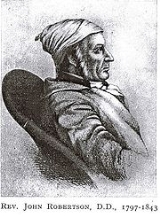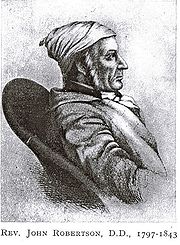
John Robertson, Minister
Encyclopedia
John Robertson, was Minister
of Cambuslang
from 1810 until his death. He was responsible for that Parish's
entry in the Second Statistical Account of Scotland
dated 1836, though he did not write it himself. (The text modestly contrasts "the author of the present text" (actually, the Rev. William Patrick
) with "the present venerable and learned incumbent of Cambuslang") He was nephew of the Scottish Enlightenment
He was nephew of the Scottish Enlightenment
historian
William Robertson
, Principal of Edinburgh University.
Robertson was born circa
1768, he was licensed by the Presbytery of Lanark
on the 8th of May, 1795, when he was made assistant to Dr Meek
, his predecessor. He was ordained as assistant minister on 22 August 1797 and took over the Parish as Minister in 1810 on the death of Dr Meek. His one publication, "Lay Preaching indefensible on Scriptural Principles," appeared in octavo
form, in Glasgow
, 1800 followed swiftly by a pamphlet rebutting criticism of his arguments. In 1813 he married Sarah, eldest daughter of William Shaw, bookseller, Glasgow
. He had two sons, both educated at Glasgow University. The elder, William, was Minister of Monivaird in Strathearn
from 1843 until his death in 1864. He was a composer of many hymns, including "A little child the saviour came". The younger son, Alexander", became a "clerk" in the Glasgow Royal Infirmary
, and later died from a wound he received while assisting at a dissection
. He also had four daughters one of whom, Elizabeth died along with her mother, in 1831, possibly of cholera
. We know the name of another daughter, Joanna, who survived and married.
Glasgow University conferred the degree of D.D
upon Mr Robertson in 1826, possibly in recognition of his work among the poor. In 1826, he argued for and secured a contract to improve the Turnpike Road
giving work to the unemployed. He was in ill health from at least 1833 and often had to call on fellow ministers for help. The last Kirk Session which he chaired personally was 2 January 1842. He died 2 February 1843, some four months before an historical split in the Church of Scotland. He had received his own post as minister from the Patronage
of the Duke of Hamilton
, so he may not have been in sympathy with those who left the Church on this issue. Neither do his publications seem to indicate he would have been on the side of the secessionists. These became the Free Church of Scotland
part of which eventually re-united with the Church of Scotland
in 1929. He is buried in the churchyard.
The current Church building - Cambuslang Old Parish Church - was built during his ministry. (The entry in the Statistical Account
complains about the state of the church and manse in 1836). There were also extensive alterations in 1896.
Dr Robertson's assistant was the Rev William Bain - a versifier
given to making fun of the church members.
Cambuslang clergy
The sequence of Clergy of Cambuslang reflects pretty accurately the development of the Christian Church in Scotland.-The Catholic Church:The revenues of the Parish of Cambuslang were obviously substantial enough for the priests to carry the title Rector. One - William Monypenny - had enough to...
of Cambuslang
Cambuslang
Cambuslang is a suburban town on the south-eastern outskirts of Glasgow, Scotland. It is within the local authority area of South Lanarkshire. Historically, it was a large rural Parish incorporating nearby hamlets of Newton, Flemington, and Halfway. It is known as "the largest village in...
from 1810 until his death. He was responsible for that Parish's
Parish
A parish is a territorial unit historically under the pastoral care and clerical jurisdiction of one parish priest, who might be assisted in his pastoral duties by a curate or curates - also priests but not the parish priest - from a more or less central parish church with its associated organization...
entry in the Second Statistical Account of Scotland
Statistical Accounts of Scotland
The Statistical Accounts of Scotland are three series of documentary publications covering life in Scotland in the 18th, 19th and 20th centuries....
dated 1836, though he did not write it himself. (The text modestly contrasts "the author of the present text" (actually, the Rev. William Patrick
William Patrick, minister
The Reverend William Patrick was a 19th Century Minister of the Church of Scotland and a significant contributor to the Second, or New, Statistical Account of Scotland. He seems to have been the prime author of the Parish accounts for Hamilton , Blantyre , Bothwell and Cambuslang...
) with "the present venerable and learned incumbent of Cambuslang")

Age of Enlightenment
The Age of Enlightenment was an elite cultural movement of intellectuals in 18th century Europe that sought to mobilize the power of reason in order to reform society and advance knowledge. It promoted intellectual interchange and opposed intolerance and abuses in church and state...
historian
Historian
A historian is a person who studies and writes about the past and is regarded as an authority on it. Historians are concerned with the continuous, methodical narrative and research of past events as relating to the human race; as well as the study of all history in time. If the individual is...
William Robertson
William Robertson (historian)
William Robertson FRSE FSA was a Scottish historian, minister of religion, and Principal of the University of Edinburgh...
, Principal of Edinburgh University.
Robertson was born circa
Circa
Circa , usually abbreviated c. or ca. , means "approximately" in the English language, usually referring to a date...
1768, he was licensed by the Presbytery of Lanark
Lanark
Lanark is a small town in the central belt of Scotland. Its population of 8,253 makes it the 100th largest settlement in Scotland. The name is believed to come from the Cumbric Lanerc meaning "clear space, glade"....
on the 8th of May, 1795, when he was made assistant to Dr Meek
James Meek
James Meek was Minister of Cambuslang from 1774 until his death. He was Moderator of the General Assembly of the Church of Scotland in 1795, but is most remembered as the model Enlightenment cleric who wrote the entry for Cambuslang in the First Statistical Account of Scotland.-Biography :James...
, his predecessor. He was ordained as assistant minister on 22 August 1797 and took over the Parish as Minister in 1810 on the death of Dr Meek. His one publication, "Lay Preaching indefensible on Scriptural Principles," appeared in octavo
Octavo
Octavo to is a technical term describing the format of a book.Octavo may also refer to:* Octavo is a grimoire in the Discworld series by Terry Pratchett...
form, in Glasgow
Glasgow
Glasgow is the largest city in Scotland and third most populous in the United Kingdom. The city is situated on the River Clyde in the country's west central lowlands...
, 1800 followed swiftly by a pamphlet rebutting criticism of his arguments. In 1813 he married Sarah, eldest daughter of William Shaw, bookseller, Glasgow
Glasgow
Glasgow is the largest city in Scotland and third most populous in the United Kingdom. The city is situated on the River Clyde in the country's west central lowlands...
. He had two sons, both educated at Glasgow University. The elder, William, was Minister of Monivaird in Strathearn
Strathearn
Strathearn or Strath Earn is the strath of the River Earn, in Scotland. It extends from Loch Earn in Perth and Kinross to the River Tay....
from 1843 until his death in 1864. He was a composer of many hymns, including "A little child the saviour came". The younger son, Alexander", became a "clerk" in the Glasgow Royal Infirmary
Glasgow Royal Infirmary
The Glasgow Royal Infirmary is a large teaching hospital, operated by NHS Greater Glasgow and Clyde,. With a capacity of around 1000 beds, the hospital campus covers an area of around 20 acres, situated on the north-eastern edge of the city centre of Glasgow, Scotland.-History:Designed by Robert...
, and later died from a wound he received while assisting at a dissection
Dissection
Dissection is usually the process of disassembling and observing something to determine its internal structure and as an aid to discerning the functions and relationships of its components....
. He also had four daughters one of whom, Elizabeth died along with her mother, in 1831, possibly of cholera
Cholera
Cholera is an infection of the small intestine that is caused by the bacterium Vibrio cholerae. The main symptoms are profuse watery diarrhea and vomiting. Transmission occurs primarily by drinking or eating water or food that has been contaminated by the diarrhea of an infected person or the feces...
. We know the name of another daughter, Joanna, who survived and married.
Glasgow University conferred the degree of D.D
Doctor of Divinity
Doctor of Divinity is an advanced academic degree in divinity. Historically, it identified one who had been licensed by a university to teach Christian theology or related religious subjects....
upon Mr Robertson in 1826, possibly in recognition of his work among the poor. In 1826, he argued for and secured a contract to improve the Turnpike Road
Turnpike trust
Turnpike trusts in the United Kingdom were bodies set up by individual Acts of Parliament, with powers to collect road tolls for maintaining the principal highways in Britain from the 17th but especially during the 18th and 19th centuries...
giving work to the unemployed. He was in ill health from at least 1833 and often had to call on fellow ministers for help. The last Kirk Session which he chaired personally was 2 January 1842. He died 2 February 1843, some four months before an historical split in the Church of Scotland. He had received his own post as minister from the Patronage
Patronage
Patronage is the support, encouragement, privilege, or financial aid that an organization or individual bestows to another. In the history of art, arts patronage refers to the support that kings or popes have provided to musicians, painters, and sculptors...
of the Duke of Hamilton
Duke of Hamilton
Duke of Hamilton is a title in the Peerage of Scotland, created in 1643. It is the senior dukedom in that Peerage , and as such its holder is the Premier Peer of Scotland, as well as being head of both the House of Hamilton and the House of Douglas...
, so he may not have been in sympathy with those who left the Church on this issue. Neither do his publications seem to indicate he would have been on the side of the secessionists. These became the Free Church of Scotland
Free Church of Scotland (1843-1900)
The Free Church of Scotland is a Scottish denomination which was formed in 1843 by a large withdrawal from the established Church of Scotland in a schism known as the "Disruption of 1843"...
part of which eventually re-united with the Church of Scotland
Church of Scotland
The Church of Scotland, known informally by its Scots language name, the Kirk, is a Presbyterian church, decisively shaped by the Scottish Reformation....
in 1929. He is buried in the churchyard.
The current Church building - Cambuslang Old Parish Church - was built during his ministry. (The entry in the Statistical Account
Statistical Accounts of Scotland
The Statistical Accounts of Scotland are three series of documentary publications covering life in Scotland in the 18th, 19th and 20th centuries....
complains about the state of the church and manse in 1836). There were also extensive alterations in 1896.
Dr Robertson's assistant was the Rev William Bain - a versifier
Versifier
* a poetaster* the versificator regis, or "king's poet"...
given to making fun of the church members.

